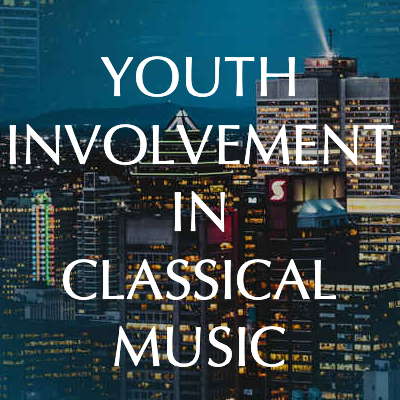 VIDEO PODCAST: John Dante Prevedini leads a discussion about Youth Involvement in Classical Music - this specially extended illustrated feature includes contributions from Christopher Morley, Gerald Fenech, Halida Dinova, Patricia Spencer and Roderic Dunnett.
VIDEO PODCAST: John Dante Prevedini leads a discussion about Youth Involvement in Classical Music - this specially extended illustrated feature includes contributions from Christopher Morley, Gerald Fenech, Halida Dinova, Patricia Spencer and Roderic Dunnett.
- Aaron Copland
- Sven-David Sandström
- Anatol Liadov
- Martino Tirimo
- Christoph Graupner
- Donald Runnicles
- Florida Grand Opera
- MusicLogo computer language
 VIDEO PODCAST: James Ross and Eric Fraad discuss Streaming, Downloads and CDs with Maria Nockin, Mary Mogil, David Arditti, Gerald Fenech, John Daleiden, John Dante Prevedini, Lucas Ball and Stephen Francis Vasta.
VIDEO PODCAST: James Ross and Eric Fraad discuss Streaming, Downloads and CDs with Maria Nockin, Mary Mogil, David Arditti, Gerald Fenech, John Daleiden, John Dante Prevedini, Lucas Ball and Stephen Francis Vasta.
Osborn Triumphs in 'Elisir'
GIUSEPPE PENNISI is back in his usual seat at Teatro dell'Opera di Roma for Donizetti's melodramma giocoso
11 January 2023 - row 14, seat 23 - my usual 'workstation' at the Teatro dell'Opera di Roma. This was the first of a cycle of performances of L'elisir d'amore by Gaetano Donizetti - a revival of a 2011 production. In short, from the mists of Verdi's Don Carlo seen and heard in Florence on 8 January, I moved to a bright village in the Basque Country, stylized - with scenery by Nicola Rubertelli, costumes by Carlo Poggioli, lighting by Vinicio Cheli - and with stage direction by Ruggero Cappuccio, a little too crowded by acrobats, jugglers and so on and so forth. In this production, it is not clear whether we are in the Basque Country or rather in a small Mediterranean village. The team that takes care of the scenic action comes from the experimental theater of Campania. As a result, I felt I was under the sun that warms the small Vesuvian municipalities. Even the acrobats and jugglers were more Neapolitan homegrown than Basque. However, we did not fall into jokes as one might have feared.
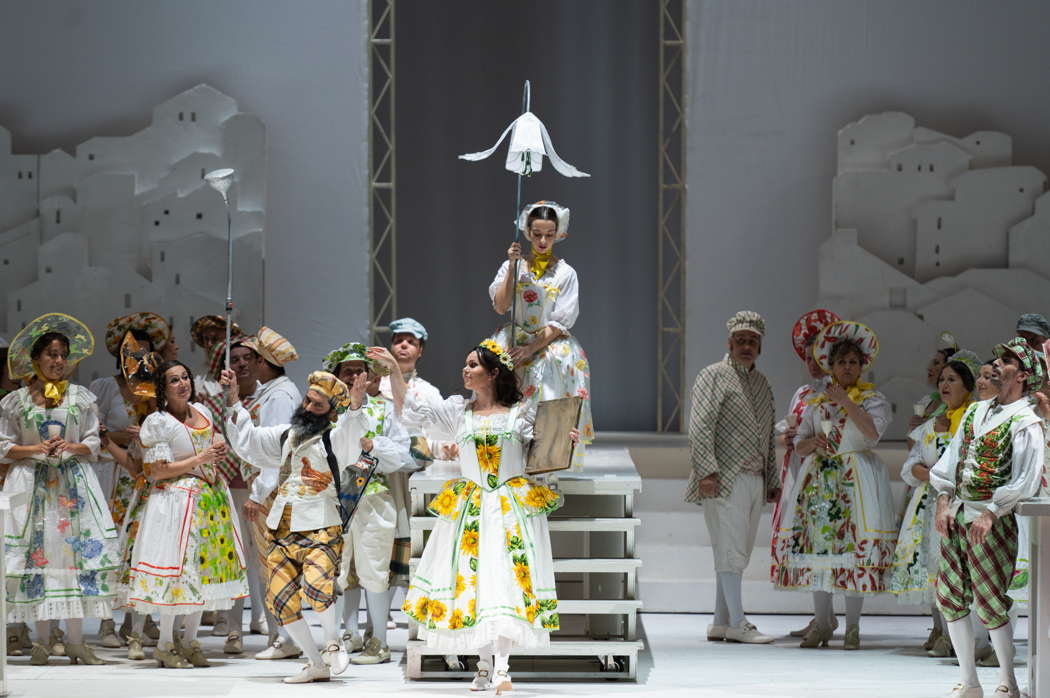
Aleksandra Kurzak as Adina in Donizetti's L'elisir d'amore at Teatro dell'Opera di Roma. Photo © 2023 Fabrizio Sansoni
The real surprise of the evening was John Osborn's Nemorino. I met him when, about twenty-five years ago, he arrived in Pesaro at the Rossini Opera Festival with a brood of young American tenors - with him were Lawrence Brownlee, Michael Spyres, and shortly before him came Chriss Merrit, Rockwell Blake and others - who had maintained the tradition of 'bel canto' of agility and a melodious voice. Since then, more than a quarter of a century has passed. Osborn has gained several pounds and is no longer the slender and athletic young man of the time, but, despite his age of fifty years, the voice has remained intact (and is not worn like that, for example, of Jonas Kaufmann, often forced to cancel). At the Rome Opera, Osborn starred in Benvenuto Cellini in 2016, Fra Diavolo in 2017, Les vêpres siciliennes, the inaugural opera of the 2019-20 season, and I puritani in 2022 - all reviewed here in this magazine.
There was lots of open scene applause. The applause meter went to the stars when Osborn faced the fearsome 'Una furtive lacrima', in which, accompanied almost exclusively by the bassoon, he showed great mastery, challenging the B flat of the first verse and going gently to the D flat of the second to the high C and to the final B natural. This was a memorable interpretation also because the very clear timbre manages to express all the nuances - even the B natural - of a very tender and sweet 'larmoyant' including 'Cielo, si può morir' tinged with erotic impulses that explode when Adina enters the scene. The audience clamored for an encore and the ovations did not end until Osborn started to repeat the entire aria. There was more thunderous applause and a request for a new encore, which was not granted. It is rare that an entire aria is repeated, especially with the difficulties of 'Una furtiva lacrima'. However, this aria is the key to understanding the whole opera.
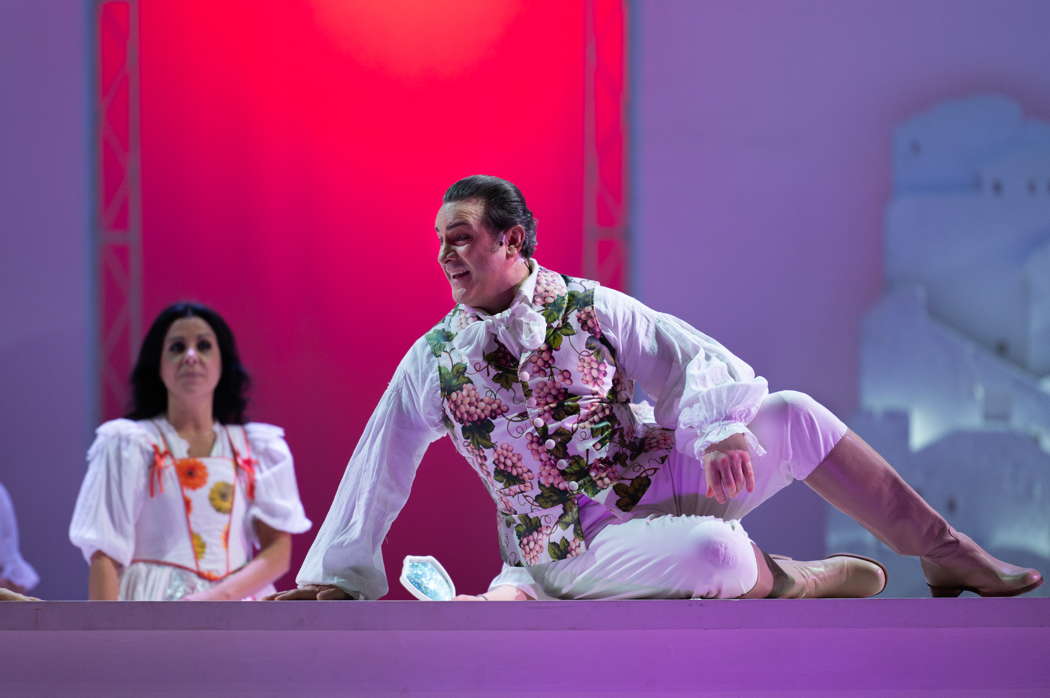
John Osborn as Nemorino in Donizetti's L'elisir d'amore at Teatro dell'Opera di Roma. Photo © 2023 Fabrizio Sansoni
Commenting on various stagings of L'elisir d'amore in this and other magazines, I emphasized that it is a 'melodramma giocoso' - such is the official description - by Felice Romani, set to music by Gaetano Donizetti. Like all masterpieces, it is fraught with traps that the most simplistic executions conceal by accentuating jokes made possible by the libretto. It is a work of the full maturity of a thirty-five-year-old Donizetti and on the crest of the wave as required by the major theaters. It is also the only apparently light opera among many dark dramas - Anna Bolena, Fausta, Ugo Conte di Parigi, Torquato Tasso and Lucrezia Borgia - which characterize a creative period of Bergamo's composer troubled by personal problems and the very first hints of the disease that, ten years later, would lead him to madness and death.
It is not an opera buffa in itself, but a perfect mechanism in which various genres are combined, some of which are understandable only to the public of 1832, the year of the premiere (or so). Of the four protagonists, only the bass Dulcamara belongs to the category of 'buffo'. Belcore is a very refined satire, instead, of the conventions of the opera seria in danger of extinction - think of the aria 'Come Paride vezzoso'. Nemorino and Adina are characters, even vocally, from comédie larmoyante - like, in Italian theater, Rossini's La Gazza Ladra. Not for nothing, they were among the workhorses by Giuseppe Di Stefano, Nicolai Gedda, Carlo Bergonzi and Afredo Kraus (for the first role) and Bidù Sayao, Renata Scotto, Mirella Freni and Joan Sutherland (for the latter). This creates discrepancies between the musical part and the scenic action in this fine Roman production. L'elisir by Felice Romani and Gaetano Donizetti is an admirable jewel to touch gently and without mixing it with other low priced jewelry - neither plastic nor Swarowki.
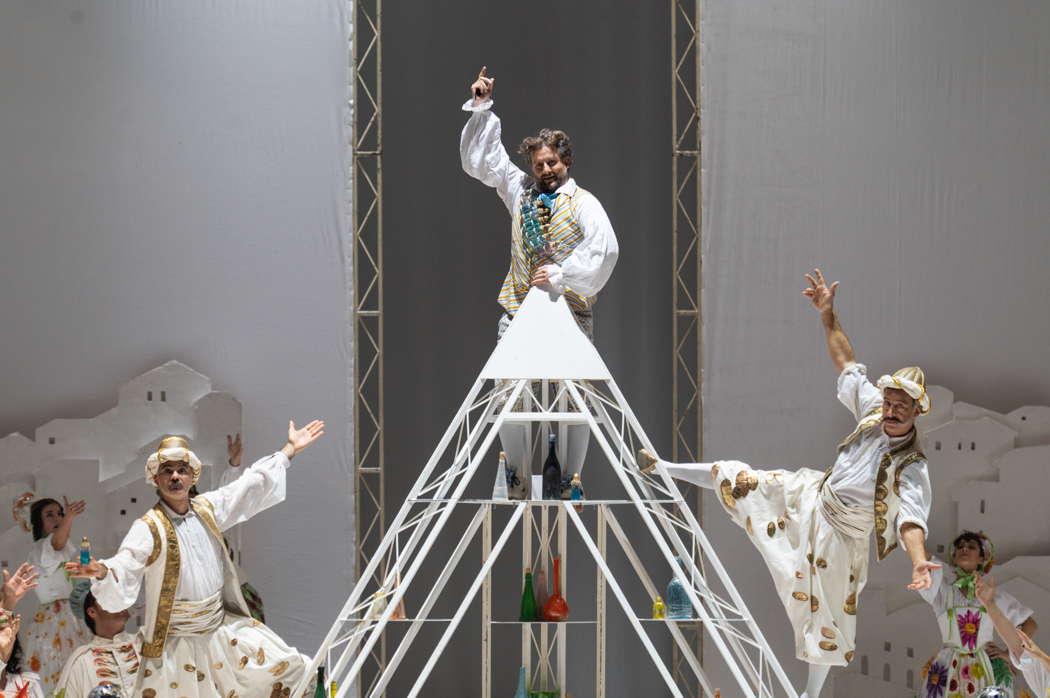
Simone Del Savio as Dulcamara in Donizetti's L'elisir d'amore at Teatro dell'Opera di Roma. Photo © 2023 Fabrizio Sansoni
Let us not forget that the most complete interpretations by Luciano Pavarotti, when he was in the splendor of his career, were precisely those in which he played - with his size - the role of the young and tender peasant in lovesickness. To the vocal traps, orchestral ones have to be added. Even in full maturity, Donizetti did not have in the Elisir the orchestral composure of his other works, such as those entitled to the three Tudor queens or the operas composed in France.
The orchestral balance is unstable with the wind and brass - mainly the trombones - that tend to overwhelm the other instruments and at certain times to cover the singers. L'elisir, finally, was designed for a theater - the Milanese Theater of the Cannobbiana - of medium-small size, where none of the performers had to make an effort. Very good, as always, was the orchestra conducted by Francesco Lanzillotta: he made you feel the veil of melancholy, which pervades the whole score, even in the most comical moments. The chorus prepared by Ciro Visco is of a high level
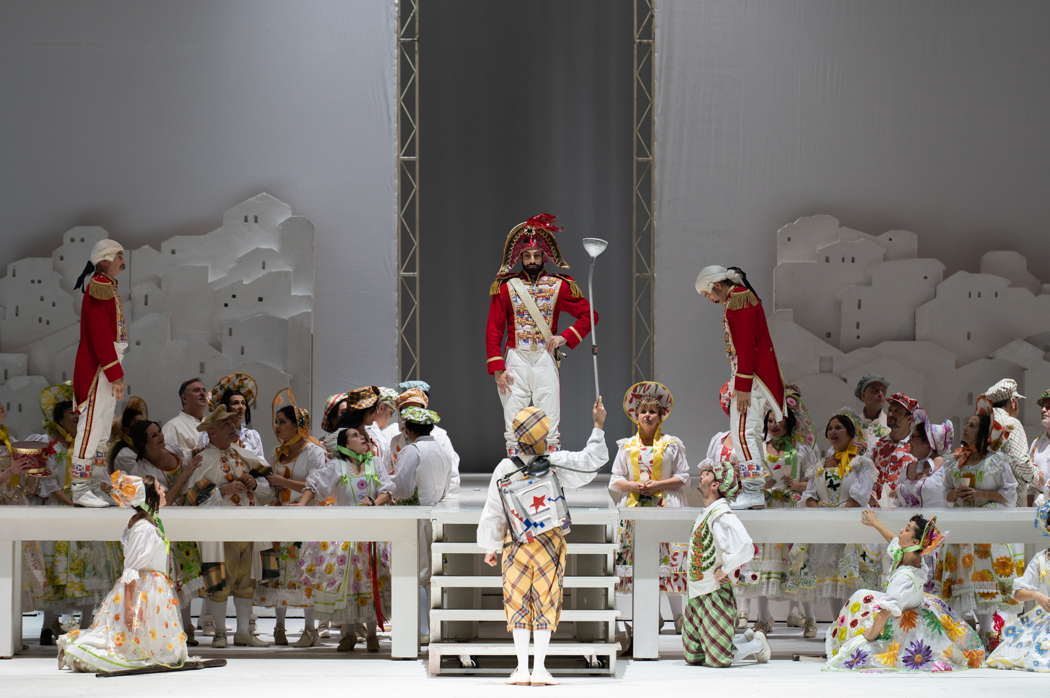
Alessio Arduini as Belcore with members of the chorus in Donizetti's L'elisir d'amore at Teatro dell'Opera di Roma. Photo © 2023 Fabrizio Sansoni
Let us go to the voices. Alessio Arduini (a proud Belcore), Simone De Savio (a superb and conceited Dulcamara) and Giulia Mazzola (a sweet Giannetta) are solid experts in their respective roles; you bet with the certainty of winning.
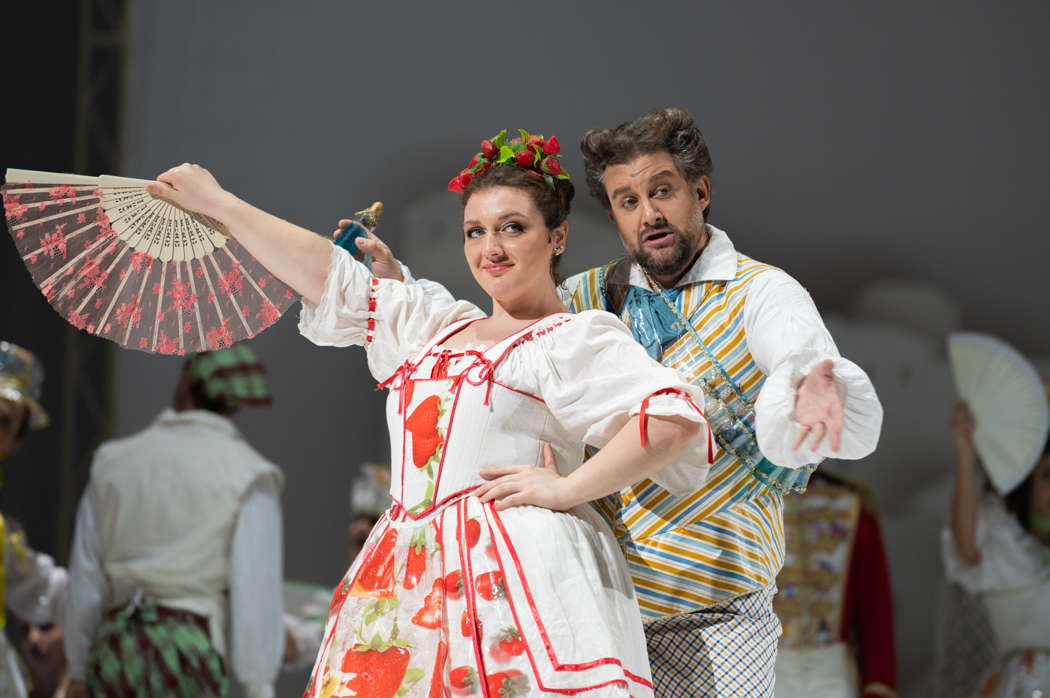
Giulia Mazzola as Giannetta and Simone del Savio as Dulcamara in Donizetti's L'elisir d'amore at Teatro dell'Opera di Roma. Photo © 2023 Fabrizio Sansoni
This review has discussed Osborn at some length. Adina is Aleksandra Kurzak, an international star, very much at home at the Metropolitan Opera House in New York, in Rome for the first time. The Polish soprano, daughter and pupil of Jolanta Zmurko, with whom she debuted on the stage, began her career as a coloratura soprano, interpreting parts such as that of the Queen of the Night in The Magic Flute or Olympia in The Tales of Hoffmann. She then expanded her repertoire with lyric soprano roles such as Mimì in La bohème or Desdemona in Verdi's Otello, going so far as to touch verismo with Santuzza in Mascagni's Cavalleria rusticana. Now, therefore, she has the voice of an 'absolute soprano' with a very wide register. Adina's role is ambiguous, but not as a coloratura lyric soprano (as often performed). It is such in the final rondò but at other times - 'Ah! Fu con te verace' - seems to anticipate Verdi's sopranos. So, the right choice for the role.
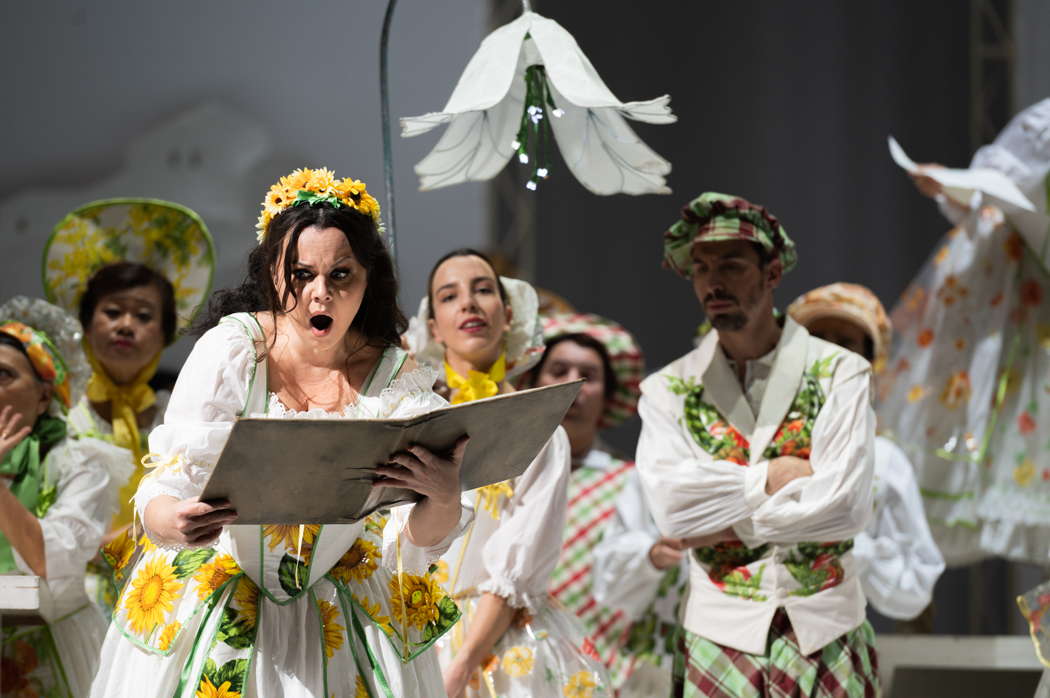
Aleksandra Kurzak as Adina in Donizetti's L'elisir d'amore at Teatro dell'Opera di Roma. Photo © 2023 Fabrizio Sansoni
At the fall of the curtain, there was long prolonged applause for everyone - but with some protests for the stage direction - and there were ovations for Osborn.
Copyright © 13 January 2023
Giuseppe Pennisi,
Rome, Italy



